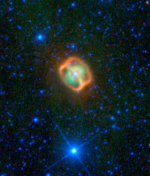
Dr. Phil Plait has published his selections of the best astronomy pictures of 2010. Not only will you see awesome pictures, but each has an explanation, like the full version of the cropped picture you see here.
Whenever a new type of instrument is used to examine the skies, surprises are guaranteed. And when the Wide-Field Infrared Survey Explorer (WISE) started scanning the heavens in 2010, it returned one amazing view after another. My favorite by far is this one, showing NGC 1514, a dying star shedding material.
This image, in the far-infrared, is very different than optical shots of the nebula, which show it looking more like a disk. It’s not certain just why this object has these two rings, but it’s likely that dust ejected from the dying star is slamming into gas previously thrown off. That older gas is most likely in an hourglass shape, common in such objects. Perhaps the dust is hitting the inside of that hourglass figure, making the rings. Maybe it’s a different reason entirely. We don’t know!
 Dr. Phil Plait has published his selections of the best astronomy pictures of 2010. Not only will you see awesome pictures, but each has an explanation, like the full version of the cropped picture you see here.
Dr. Phil Plait has published his selections of the best astronomy pictures of 2010. Not only will you see awesome pictures, but each has an explanation, like the full version of the cropped picture you see here.
No comments:
Post a Comment